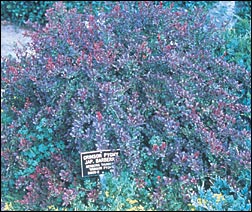
Many varieties of barberry are available locally, most of which have yellow flowers in spring and spines on their branches (unless otherwise noted). This shrub tolerates poor soils, heat, wind, drought and extreme cold. It looks best with occasional pruning of the interior branches to admit sunlight or it gets so thick it looks dead in the middle. Looks best when grown in well-drained soils, full sun and watered once-a-week.
B. gladwynensis William Penn 6 ft. tall by
6 ft. wide; black berries; evergreen to 0°F, then deciduous
B. mentorensis (Mentor Barberry) 7 ft. tall and wide; dull red berries; red fall color; makes a good hedge or barrier; evergreen
to -5° F
B. thunbergii (Japanese Barberry) 4-6 ft. tall and wide; green leaves; red berries; barrier, hedge or specimen
B. t. Atropurpurea (Red-Leaf Barberry)
4 ft. tall and wide; needs sun to maintain color
B. t. Aurea (Golden Barberry) 3 ft. tall by
2 ft. wide; bright yellow foliage; needs full sun to maintain leaf color
B. t. Crimson Pygmy remains dwarf at
1 ft. tall by 2 ft. wide; bright red leaves; needs full sun
B. t. Kobold 1 ft. tall by 3 ft. wide; bright lime green leaves; needs full sun
B. t. Rose Glow 5 ft. tall by 4 ft. wide; red, pink, and white in each leaf; full sun
